- Joined
- 27 Jan 2008
- Messages
- 25,831
- Reaction score
- 3,063
- Location
- Llanfair Caereinion, Nr Welshpool
- Country

Not sure on that, a parabolic reflector is designed to cover an area with even light, as to a multifaceted reflector clearly spread will not be the same, and today we have neither,
 looking at the inside of this GU10 lamp,
looking at the inside of this GU10 lamp, 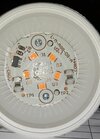 this one will clearly have a different spread. Add diffuser
this one will clearly have a different spread. Add diffuser 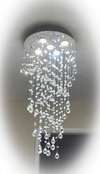 and the light spread will change yet again. As said, height matters
and the light spread will change yet again. As said, height matters  my son had loads of height, and well spread out, but the LED down lights are no better to the 58 watt fluorescent they replaced, 12 x 5 watt, so same wattage as near as damn it, so much for LED being better, however in between the two had a 22 watt LED tube, and really that was good enough.
my son had loads of height, and well spread out, but the LED down lights are no better to the 58 watt fluorescent they replaced, 12 x 5 watt, so same wattage as near as damn it, so much for LED being better, however in between the two had a 22 watt LED tube, and really that was good enough.
Often wondered what they would look like arranged as the great bear?
However, looking at too completely different things. The son's down light looked better than the fluorescent tube, even if both did the same thing, My kitchen counters have lights under the wall cupboards above them to light the counter, not the main ceiling lights.
So my living room, main light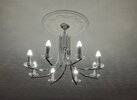 is not good enough to work on the dinning table, so we have an up-light
is not good enough to work on the dinning table, so we have an up-light 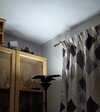 we also have cabinet lights,
we also have cabinet lights, 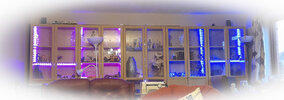 and we select lights depending on what we are doing. And we use Google Nest Mini, so single voice command "Hey google turn off living room lights" turns them all off, does not matter if from lighting supply or sockets.
and we select lights depending on what we are doing. And we use Google Nest Mini, so single voice command "Hey google turn off living room lights" turns them all off, does not matter if from lighting supply or sockets.
We have a dinning room, but never use it, we have a craft room, not used much, we have an office, rarely used, we do all in the living room, so the living room must be flexible. So sometimes just back-ground lighting wanted, when watching TV, other times some rather harsh lights are required, so we want a room where we can select lighting to suit what we are doing that day.
 looking at the inside of this GU10 lamp,
looking at the inside of this GU10 lamp,  this one will clearly have a different spread. Add diffuser
this one will clearly have a different spread. Add diffuser  and the light spread will change yet again. As said, height matters
and the light spread will change yet again. As said, height matters  my son had loads of height, and well spread out, but the LED down lights are no better to the 58 watt fluorescent they replaced, 12 x 5 watt, so same wattage as near as damn it, so much for LED being better, however in between the two had a 22 watt LED tube, and really that was good enough.
my son had loads of height, and well spread out, but the LED down lights are no better to the 58 watt fluorescent they replaced, 12 x 5 watt, so same wattage as near as damn it, so much for LED being better, however in between the two had a 22 watt LED tube, and really that was good enough.Often wondered what they would look like arranged as the great bear?
However, looking at too completely different things. The son's down light looked better than the fluorescent tube, even if both did the same thing, My kitchen counters have lights under the wall cupboards above them to light the counter, not the main ceiling lights.
So my living room, main light
 is not good enough to work on the dinning table, so we have an up-light
is not good enough to work on the dinning table, so we have an up-light  we also have cabinet lights,
we also have cabinet lights,  and we select lights depending on what we are doing. And we use Google Nest Mini, so single voice command "Hey google turn off living room lights" turns them all off, does not matter if from lighting supply or sockets.
and we select lights depending on what we are doing. And we use Google Nest Mini, so single voice command "Hey google turn off living room lights" turns them all off, does not matter if from lighting supply or sockets.We have a dinning room, but never use it, we have a craft room, not used much, we have an office, rarely used, we do all in the living room, so the living room must be flexible. So sometimes just back-ground lighting wanted, when watching TV, other times some rather harsh lights are required, so we want a room where we can select lighting to suit what we are doing that day.
